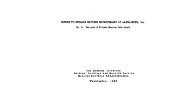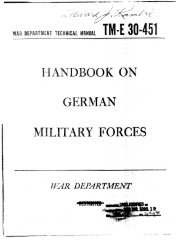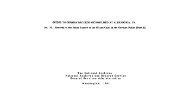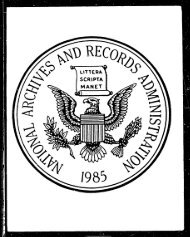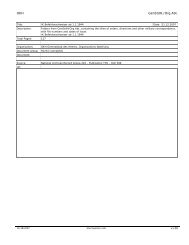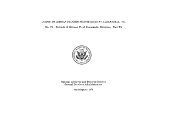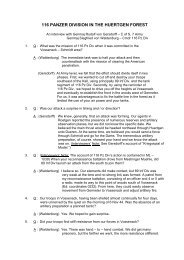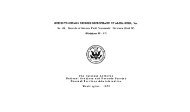and supervisors. The foreign workers <strong>com</strong>pose the OT labour armywhich performs the actual work on OT construction projects, and<strong>com</strong>prise about 8($ of all OT personnel. Prom the standpoint ofOT administration, they are not properly speaking "OT personnel";they merely "work for the OT" and accordingly wear an armband withthe inscription "Arbeitet fttr OT". Moreover they are bound to theOT in various forms, ranging from local labour contracted to theOT on a voluntary basis and permitted to go home nightly, toforced labour permanently restricted to their own camp and not entitledeven to a day of rest. A number of Russian women classifiedby the Germans as partisans and conmunists, amounting it isestimated to a few thousand, was included in the latter group.Inasmuch as it is onerous, in many instances, to make the distinctionreferred to above, the term "OT personnel", for the purposes of thishandbook, can be presumed also to include the category Auslandischebi5) Women.OT female personnel have been listed in the appropriatefunctional groups: Nachrichtenhelferinnen (Telephone, telegraph,teletype operators, messengers, etc.); female clerks-in OT administrativeoffices and in firm offices; female menial help in kitchen,camps, etc. Those in the last group were natives, mostly local,whose relationship to the OT is somewhat tenuous. Certainly nodisciplinary measures were taken against those who took informalleave. Special quarters for women were, however, available in OTcamps and centres.b) Construction Personnel*and Camps.i) Supervisory Field Staffs.U6. Under Normal Conditions.The NCO runs the OT just as much as, if not more than, he maybe said to run the regular aimy. However, in the process ofbe<strong>com</strong>ing 8($ foreign in respect to its personnel (as opposed to thevirtually 100^ German <strong>com</strong>position in May 193^) > the <strong>com</strong>position ofthe NCO cadre underwent a similar change in nationality, althoughto a much smaller proportion than the rest of the organisation*Before the shortage of manpower upset its plans, .Apt Bau-OTZplanned to control the daily routine of its manual labour byplacing fl"n or as much oontrol as possible in the hands of Germans.(This statement should not be interpreted as implying that, hadGermany ended the war victoriously, the OT would not have effecteda working arrangement in occupied territory which would have delegateda measure of control to collaborationist elements, Fhat ismeant is that in being confronted with what was believed to be atemporary military situation, the OT had no definite political orsocial policy, except to get as much work performed in as short aperiod as possible. The policy adopted during the first two yearsin occupied territories (1940-42) when supervision and securitywas predominately in German hands, was, on the whole, brutal;later when Geiman personnel was withdrawn and the need for foreignmanpower became imperative, attempts were made at pacification andappeasement. By spring 1944, official regulations for the treatmentof foreign workers had assumed sane humane characteristics. Howeffectively these regulations were carried out by petty officialsin charge is another story).at The conditions in the West are taken as standard, and mostreferences in this section are made to EGW (Einsatzgruppe West).
Control during working hours - under normal conditions - wasplaced in the hands of the technical staff of the OT-fizm,*<strong>com</strong>posed of (1) the firm executive, in charge of construction inthe entire area in which the firm was active; (2) the latter sassistants in charge of the individual pieces of construction;(3) their foremen, for the greater part skilled in excavation andunderground construction, which is the basic type of work done bythe OT. The two former carried OT officer rank. The last twomentioned carried NDO rank, their assignment consisting of thesupervision of section gangs on the construction Job, They broughtwith them into the OT from civilian life their trade giildoccupational grade, such as Polier (and/or Schachtmeister)(roughly translatable as * excavation and tunnelling foremen 1 , or•pit or shaft overseer 1 ). Their OT rank could be any fromObermeister to Obertruppfuhrer (corporal to staff sergeant).This dual classification of both occupational grade andmilitary rank i s given to firm employees who at the same time havesupervisory assignments over OT organic personnel, such as foreignworker detachments. Consequently the grade of Polier and Schachtmeisterin the OT is not restricted to those in charge ofexcavation work, but is given to all firm employees with <strong>com</strong>parablyresponsible assigaaents (see para. 118 below). Moreover a Polier ora Sohachtmeister can be promoted to Oberpolier or Oberschachtmeisterwhile working for the OT, if he is considered as having satisfiedthe trade guild requirements in this respect. Such promotion inoccupational grade does not, however, automatically involve acorresponding promotion in OT rank. German personnel in loweroccupational grades could, in like manner, be promoted to Polieror Schachtmeister.Control in the camp and to and from work was placed in thehands of OT-eigenes Personal (organic personnel) of appropriate1IC0 rank such as Truppfuhrer (Sergeant) • Their assignment wasnormally that of either Front truppfuhrer or Obertruppfuhrer.Supervision of • Zwangsarbeiter 1 (forced labour) was largely entrustedto the SK (schutzkcmmando or Security Guard). On theconstruction job the duties of the Front and Obertruppfuhrerwere subordinated to those of the Poliere and Schachtmeister inthat the former were to help the latter keep discipline amongsttheir men, convoy additional manpower needed in the course of theday, be alert for signs of sabotage, and so forth. At the end ofthe working day, it became the duty of the Polier to send his meninto the proper formations, ready to leave for camp. The dutiesof the Polier and the Schachtmeister thus ended with the workingday, and the OT-eigenes Personal (OT organic personnel) tookcharge of the men until time for work the next day. Overallcontrol rested in the Frontfuhrung of the GBL and its staff. Acheck was kept on the morale amongst foreign workers through theemployment of collaborationist agents who mixed with their countrymenas co-workers or "social service" agents. These agents werethe eyes and ears of the Frontfuhrer and the SS-Verbindungsfuhrer(SS-Liaison Officer).117. Modifications in Supervisory Field Staffs due to shortage ofGerman Personnel.A3 implied above, supervisory assignnents in the PersonalLager (Camp), usually called simply "Lager", gradually becameentrusted to foreigners. An effort was made to stabilise thissituation by issuing a series of new regulations (contradictory insome instanoes) during the spring of 1944. The re-organisationwhich resulted may be summarised as follows:ac This staff <strong>com</strong>prises the Firmen Stammpersonal (permanent firmstaff), that is to say, the irreducible minimum staff, withoutwhich no OT-f inn will be allotted foreign manpower by'the OTadministr at ion •-123
- Page 1 and 2:
IR5/f!lR-0T/5/4SHRnDBOOK OF THEDRcn
- Page 3 and 4:
GE R MAN YOT EINSATZGRUPPEN, AUTUMN
- Page 5 and 6:
TABLE OP CONTENTS(See also LIST OP
- Page 7 and 8:
4a. OrganizSferiy %f Sfciw t>T& ^ ^
- Page 9 and 10:
Page35. "Current Organization" Eins
- Page 11 and 12:
155» Miscellaneous Deductions and
- Page 13 and 14:
To-day PT is indispensable in any p
- Page 15 and 16:
UNCLASS13* The two "basic types 6_
- Page 17 and 18:
of control over its plans, which we
- Page 19 and 20:
OT units was that of Bautrupps (Con
- Page 21 and 22:
__ n be committed to work by order
- Page 23 and 24:
11. OT Construction Activities 1942
- Page 25 and 26:
In case of Allied landings. In the
- Page 27 and 28:
Factors militating against complete
- Page 29 and 30:
1* Rationalization^ on a nation wid
- Page 31 and 32:
The project itself cannot be accept
- Page 33 and 34:
areas within the Reich; (3) Einsatz
- Page 35 and 36:
has the final responsibility for me
- Page 37 and 38:
Matters of policy, as decided upon
- Page 39 and 40:
with the Wehrmacht and with civil a
- Page 41 and 42:
which do the actual work. This is o
- Page 43 and 44:
adjacent construction sites are gro
- Page 45 and 46:
Amt Bau-OTZ.The second ia the auton
- Page 47 and 48:
are to be employed in tha execution
- Page 49 and 50:
"Current Organization" Bauleitung (
- Page 51 and 52:
Former Hauptabteilungen in OTZ have
- Page 53 and 54:
(SS Liaison Officer) are the follow
- Page 55 and 56:
y the Array for the construction of
- Page 57 and 58:
fortresses stretch over its entire
- Page 59 and 60:
(Eastern Wall) in April 1943* At on
- Page 61 and 62:
obviously would also have the same
- Page 63 and 64:
Consequently ten lype A emplacement
- Page 65 and 66:
at the expense of the "private comm
- Page 67 and 68:
eside those of feeding and billetin
- Page 69 and 70:
57* Construction Programme, Materia
- Page 71 and 72:
Italian firms arid the workers is c
- Page 73 and 74:
"The large scale construction work
- Page 75 and 76:
Diplom - Ingenieur "* Paul ANDORY,
- Page 77 and 78:
Para. 7 ~ CompensationCompensation
- Page 79 and 80:
Para* 16 - Text of the ContractThe
- Page 81 and 82:
m tag » * u »"5. For ascertaining
- Page 83 and 84: - Delivery of Building MaterialThe
- Page 85 and 86: prior consent of the HU. Any assign
- Page 87 and 88: ecause of Allied propaganda and the
- Page 89 and 90: all replacement parts of machine we
- Page 91 and 92: served only as a general directive.
- Page 93 and 94: The transport organizations forking
- Page 95 and 96: outside the "boundaries of the Reic
- Page 97 and 98: d) Health and Medical Services77. M
- Page 99 and 100: tfhTheading "identifying scars or w
- Page 101 and 102: example, units of the Feldgendanaer
- Page 103 and 104: set up within the region of each Ar
- Page 105 and 106: Sc^al Festungspionier stab, (Portre
- Page 107 and 108: Refer at (Sub Unit) BII1 : Hochbau,
- Page 109 and 110: 2. Although the agencies are subord
- Page 111 and 112: Emergency Measures1. In case of imm
- Page 113 and 114: The interests of the OT firms as an
- Page 115 and 116: of the OBL cuts across two or more
- Page 117 and 118: The following captured document, he
- Page 119 and 120: sche Nothilfe - Technical Tanarfien
- Page 121 and 122: Chef de¥iflitfSItverwaltung, Haupt
- Page 123 and 124: corresponding in area to the DHL's.
- Page 125 and 126: ij Feldpoli^ei (commonly abbreviate
- Page 127 and 128: erNSKK Verbindungsf&hrer des Transp
- Page 129 and 130: , _ .-^^-^^-^sson of aDienstbuch (P
- Page 131 and 132: ar T—all phases of OT operation.
- Page 133: B. Classicioation of Personnela) Ge
- Page 137 and 138: ii . Betriebsftihrer (Finn Manager)
- Page 139 and 140: vii,obhoer*ed. In the performance o
- Page 141 and 142: were supposed to b« numbered conse
- Page 143 and 144: In the autumn of 192*4, co-operatio
- Page 145 and 146: with the French Betreuungftthrer me
- Page 147 and 148: C; Training.129. Military Training.
- Page 149 and 150: Russians also received this trainin
- Page 151 and 152: NCO in OT - Dienst Unifom wearing M
- Page 153 and 154: only distinguishing feature being t
- Page 155 and 156: Dr. Pritz Todt Ehrennadel in Gold (
- Page 157 and 158: ff f^f(b) * OT-Eigenes Personal (OT
- Page 159 and 160: (v)the same*In December 1944, howev
- Page 161 and 162: "IT "BT •CTGefcaltsgruppe I. 2 On
- Page 163 and 164: untranslated and may be checked in
- Page 165 and 166: Up to this point OT tariffs affecti
- Page 167 and 168: a|t|jr^|| h l^fcers are paid accord
- Page 169 and 170: ftfonthlv Einsatz Pav forMarried Wo
- Page 171 and 172: IpecTaj regulations affecting OT pa
- Page 173 and 174: or.- soid(Wehrsold) G. Gouv. Russ
- Page 175 and 176: or negligence:time lost because of
- Page 177 and 178: ^rfrom service in the OT, the worke
- Page 179 and 180: MANPOWERA. General Manpower Statist
- Page 181 and 182: 162. FirmenangehgrJRe (OT»-Firm Pe
- Page 183 and 184: x» , ~«^«u u*^ of 1942, irregula
- Page 185 and 186:
The nuSKF'Wf s&lfeifrms 1 is estima
- Page 187 and 188:
equally urgent rSeP^^irniShing Germ
- Page 189 and 190:
Orders had come through to class ev
- Page 191 and 192:
The Gorman Feldkommandanturen who w
- Page 193 and 194:
Baltic Manpower179* Proportion and
- Page 195:
and to a lesser_. —ii«i4lfiU&»




